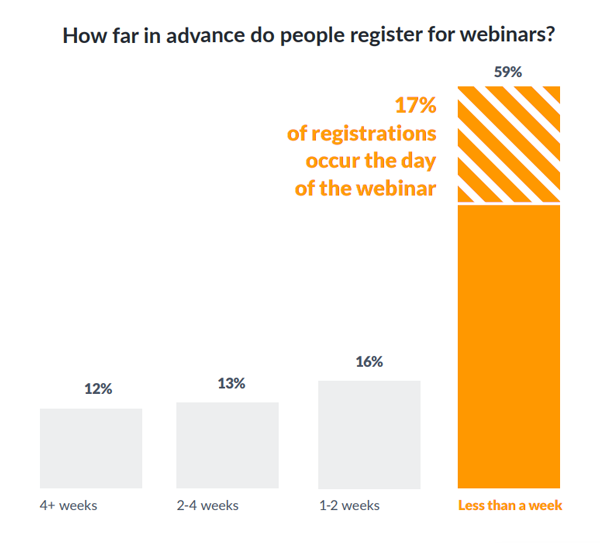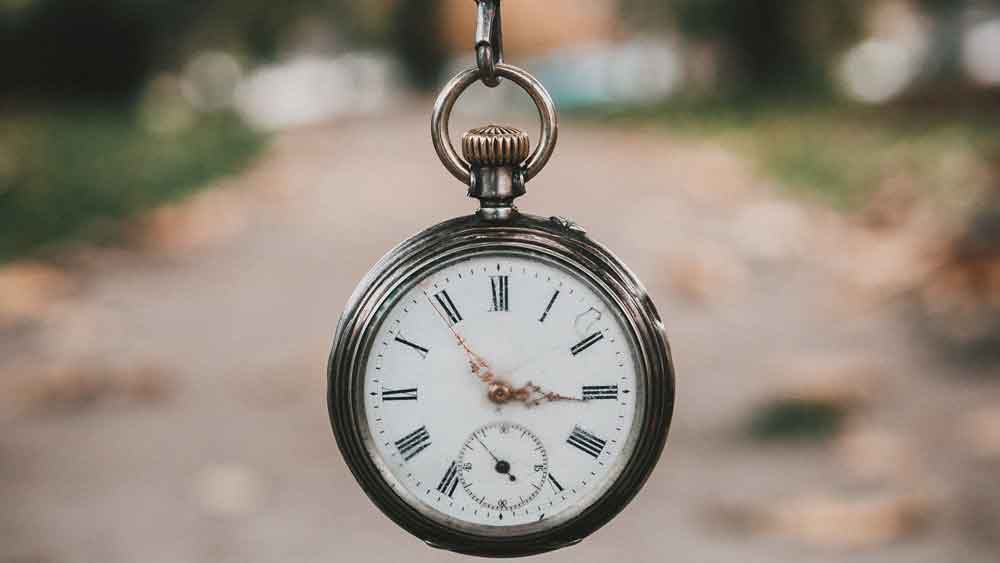Blog
CATEGORY: digital-marketingBest practiceemail-marketing
If you build it... They will come

Unfortunately it is not as easy as that – and in the current climate it is even more important to ensure that you get it right. What am I talking about? Webinars, of course.
Webinars. Are. Everywhere.
And with continued restrictions and wariness around face to face events, this trend is set to gain more traction as increasingly businesses turn to this channel to share their expertise, build their brand and develop their sales pipeline.
It is not surprising though. Webinars work and when done well can be extremely cost effective tools – having been favoured by ‘growth hackers’ for some time. Indeed, according to GoToWebinar, 73% of B2B marketers say a webinar is the best way to generate high-quality leads. But driving webinar attendance can be tricky at the moment, especially when there's so much competition fighting for your audience's attention.
So what are the essential email components to make your webinar a success?
Email invitation series
On average, email drives 79% of all webinar registrations, making it the #1 tactic to get your webinars well attended. So it is important that you put your best foot forward.
What elements should the invitation email contain?
As with all emails, a compelling subject line is a must – ideally A/B test to find the most effective. We would also suggest that you include the word webinar in the subject line and outline the key focus of the webinar in the preview text.
Include the core details:
WHAT: Your webinar title
WHEN: Time of the webinar (date, time and duration)*
WHO: Introduce the people presenting, guests, hosts, etc
HOW: Calls to action to register (buttons, links, etc)
WHY: What value and learning outcomes are you offering your attendees.
Focus on what the registrant will get from the webinar – what is in it for them. Use bullets and tease the content you will be sharing.
Have a clear CTA ie “Reserve my spot”. CTAs like “book your place” and “save your seat” imply that there is a limited number of places available, using the psychology of scarcity to motivate the click through.
Have multiple registration links, don't just have a registration button put links in the text, link titles and images/banners (if you are using them) too.
Hardcode registration buttons, to ensure that they are visible even if images are not shown.
Ensure that your messages are concise and that the first line of text grabs the audience straightaway.
* some people choose to only share the time of the webinar on the sign-up page to encourage click-throughs. NB To let more users join you, convert time according to different time zones or add a link to your email suggesting the following “Convert to my time zone”.
Whist the majority of webinar sign-ups occur in the final few days before, and indeed the day of the webinar, it is still advisable to start the promotion of your webinar around a month in advance.

But a single email invitation is not enough, you need to consider a series of mails to ensure the best attendance levels. Best practice would indicate that a series of four are required i.e.
Save the date – webinar announcement around 3-4 weeks prior
Reminder email 1 – perhaps with a teaser or example of the type of insight you will be sharing 1-2 weeks prior to the event
Reminder 2 – week before/week of event – perhaps include a more detailed agenda at this point
Last chance email – day before/day of
Don't forget that segmenting your audience based on behaviour can be very effective. For example, a targeted campaign to people that have clicked on the registration link, but then not completed the registration - perhaps offering them additional information on aspects to be covered.
To design or not to design?
We are often asked whether a plain outlook-style email or an HTML designed email drives better results. However I would argue that as you are likely promoting your webinar over several weeks in the lead up, there is plenty of opportunity to utilise both styles as part of your campaign and test which has the best conversion rates.
Just remember, particularly for the B2B audience, if you are using a message that utilises strong imagery, your key points also need to be made with imagery turned off (as those using Outlook will have images turned off by default and may never see your email in all its glory). If you are looking for some inspiration – Really Good Emails have a selection of webinar emails that you can have a look at.
Whilst the precise design of the email is something that you can test and optimise, regardless of the design, personalisation is something that should not be overlooked. Basic personalisation is “table stakes” in this type of communication, and even though we know these details are being taken from a database, as Carnegie rightly said, “There is no sweeter sound to one's ear than the sound of his name.” Other forms of personalisation increase engagement by resonating more directly with the recipient.
Another content consideration for webinar invitation emails, which is very different to all other content creation, is the sophisticated use of jargon. Whilst the use of jargon in marketing copy is usually something to avoid, when it comes to creating a webinar invitation all bets are off. In this instance, jargon and specific industry terminology serve as a signpost to highlight your expertise in the area – suggesting a deeper or technical understanding of the subject, which is especially beneficial if your target audience is experienced professionals. That said, it is still advisable to use jargon sparingly.
Transactional post-registration email series
By utilising a series of emails and building in re-sends to non-displays, you stand the best chance of getting ‘bums on seats’ for your online event. But this is just the beginning.
Don’t forget about the other more transactional emails that you need too:
Booking confirmation
1 week reminder
1 day reminder
1 hour reminder
These functional emails serve as reminders for those booked on the webinar and ideally should include the functionality to add the webinar directly into their calendar. They also give you the opportunity to gather questions in advance that you can cover in the session, but most importantly this email series is the most effective way to ensure that your registrants attend. It is also worth enabling social sharing as referral or recommendation of a peer adds further credibility - and we all understand the power of 'word of mouth' marketing.
Whilst most webinar platforms have templates for these emails, they are bland and purely functional. If you wish to add your branding or more personality to your email then you will need to integrate your email provider and webinar provider. But we talk about this in more detail below.
Post event follow up email series
Email also plays a key part in post webinar follow up and engagement with registrants who did not attend. According to GoToWebinar’s benchmark data in The Big Book of Webinar Stats, average attendance rates for marketing webinars are 36.6%. Typically they say that they see anywhere from 28-32% on their lead generation webinars. So that leaves you with the majority of your registrants in an audience that has indicated interest in the topic but did not attend the event that you need to follow up with as well.
So immediately after the event you have two distinct groups:
Those who attended
Those who did not attend
And then latterly a third group comprising
Those who viewed the recording
The key thing that your webinar registrants will be looking for in the post event comms are the slides and the recording of the session. It is also useful to indicate within the webinar other useful assets i.e. blog posts or cheat-sheets or checklists that can be sent later to continue their engagement and monitoring their activity on your website as well as interaction with your subsequent email campaigns. You can find out more about web tracking in our post “Spotting buyer behaviour on your website”.
For those that latterly view the webinar, you have the opportunity to create a series that follows the same path and utilises the same assets that the attendees were subject to after the original webinar.
Essential integration
There are several communication streams and multiple touch points that need to be managed and integrated to make your campaign a success. Webinar platforms are fantastic at enabling you to run high-quality, interactive events, but any emails that come out of these platforms are usually straightforward and functional, without your branding or your brand’s personality. Consistency across your campaign will increase form fills and attendance. This is why your tech stack needs to work in harmony so you can capitalise on the strengths of all the apps that you employ.
Through Zapier, e-shot can integrate with thousands of apps including some of the best known webinar tools including Zoom, GotoWebinar, Webinarjam, Livestorm, Crowdcaste and Easy Webinar. And to make things easy for you, we have created templates so we have done the hard work of connecting the platforms and testing them to ensure they are bullet proof. You can find out more about our Zapier integration here.
In October we will be holding our own "Webinar" webinar where we will look in more detail at how to create successful email campaigns to maximise attendance and convert registrants to qualified sales leads.
Solutions
Email marketing healthcheck
We are confident that we can help you, which is why we offer a free healthcheck to identify potential issues with your current programme and free advice on things that could be done to improve it.


